Engineering Phages to Fight Multidrug-Resistant Bacteria
- PMID: 39680919
- PMCID: PMC11758799
- DOI: 10.1021/acs.chemrev.4c00681
Engineering Phages to Fight Multidrug-Resistant Bacteria
Abstract
Facing the global "superbug" crisis due to the emergence and selection for antibiotic resistance, phages are among the most promising solutions. Fighting multidrug-resistant bacteria requires precise diagnosis of bacterial pathogens and specific cell-killing. Phages have several potential advantages over conventional antibacterial agents such as host specificity, self-amplification, easy production, low toxicity as well as biofilm degradation. However, the narrow host range, uncharacterized properties, as well as potential risks from exponential replication and evolution of natural phages, currently limit their applications. Engineering phages can not only enhance the host bacteria range and improve phage efficacy, but also confer new functions. This review first summarizes major phage engineering techniques including both chemical modification and genetic engineering. Subsequent sections discuss the applications of engineered phages for bacterial pathogen detection and ablation through interdisciplinary approaches of synthetic biology and nanotechnology. We discuss future directions and persistent challenges in the ongoing exploration of phage engineering for pathogen control.
Conflict of interest statement
The authors declare no competing financial interest.
Figures
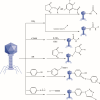










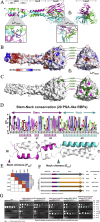

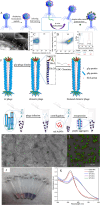

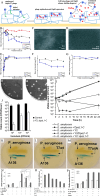
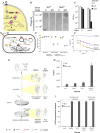

Similar articles
-
Phage-Derived Antibacterials: Harnessing the Simplicity, Plasticity, and Diversity of Phages.Viruses. 2019 Mar 18;11(3):268. doi: 10.3390/v11030268. Viruses. 2019. PMID: 30889807 Free PMC article. Review.
-
Does Phage Therapy Need a Pan-Phage?Pathogens. 2024 Jun 20;13(6):522. doi: 10.3390/pathogens13060522. Pathogens. 2024. PMID: 38921819 Free PMC article. Review.
-
Phage therapy: A targeted approach to overcoming antibiotic resistance.Microb Pathog. 2024 Dec;197:107088. doi: 10.1016/j.micpath.2024.107088. Epub 2024 Oct 29. Microb Pathog. 2024. PMID: 39477033 Review.
-
Engineering bacteriophages for targeted superbug eradication.Mol Biol Rep. 2025 Feb 11;52(1):221. doi: 10.1007/s11033-025-10332-6. Mol Biol Rep. 2025. PMID: 39934535 Review.
-
Engineering therapeutic phages for enhanced antibacterial efficacy.Curr Opin Virol. 2022 Feb;52:182-191. doi: 10.1016/j.coviro.2021.12.003. Epub 2021 Dec 21. Curr Opin Virol. 2022. PMID: 34952266 Review.
Cited by
-
Bacteriophages as Targeted Therapeutic Vehicles: Challenges and Opportunities.Bioengineering (Basel). 2025 Apr 29;12(5):469. doi: 10.3390/bioengineering12050469. Bioengineering (Basel). 2025. PMID: 40428088 Free PMC article. Review.
-
Phage Therapy in Managing Multidrug-Resistant (MDR) Infections in Cancer Therapy: Innovations, Complications, and Future Directions.Pharmaceutics. 2025 Jun 24;17(7):820. doi: 10.3390/pharmaceutics17070820. Pharmaceutics. 2025. PMID: 40733029 Free PMC article. Review.
-
Biofilm-dispersal patterns in ESKAPE pathogens.Arch Microbiol. 2025 Jul 11;207(9):194. doi: 10.1007/s00203-025-04394-0. Arch Microbiol. 2025. PMID: 40643714 Review.
-
Armed Phages: A New Weapon in the Battle Against Antimicrobial Resistance.Viruses. 2025 Jun 27;17(7):911. doi: 10.3390/v17070911. Viruses. 2025. PMID: 40733529 Free PMC article. Review.
-
Synthetic and Functional Engineering of Bacteriophages: Approaches for Tailored Bactericidal, Diagnostic, and Delivery Platforms.Molecules. 2025 Jul 25;30(15):3132. doi: 10.3390/molecules30153132. Molecules. 2025. PMID: 40807307 Free PMC article. Review.
References
-
- Ikuta K. S.; Swetschinski L. R.; Robles Aguilar G.; Sharara F.; Mestrovic T.; Gray A. P.; Davis Weaver N.; Wool E. E.; Han C.; Gershberg Hayoon A.; et al. Global mortality associated with 33 bacterial pathogens in 2019: a systematic analysis for the Global Burden of Disease Study 2019. Lancet 2022, 400, 2221–2248. 10.1016/S0140-6736(22)02185-7. - DOI - PMC - PubMed
-
- Beyer P.; Paulin S. The Antibacterial Research and Development Pipeline Needs Urgent Solutions. ACS Infect. Dis. 2020, 6, 1289–1291. 10.1021/acsinfecdis.0c00044. - DOI

